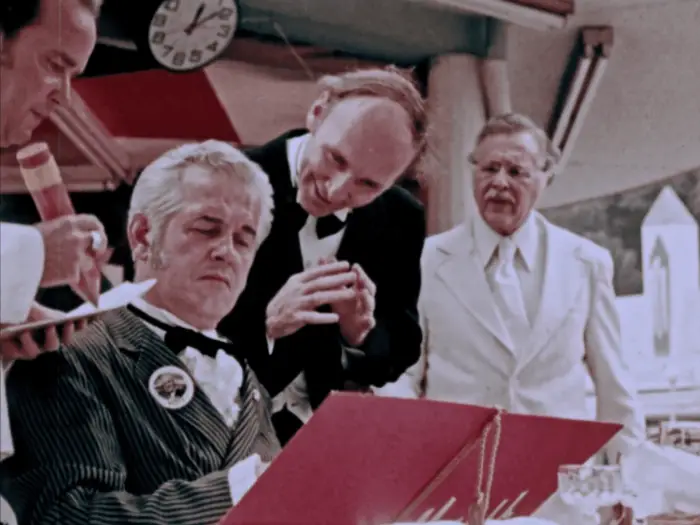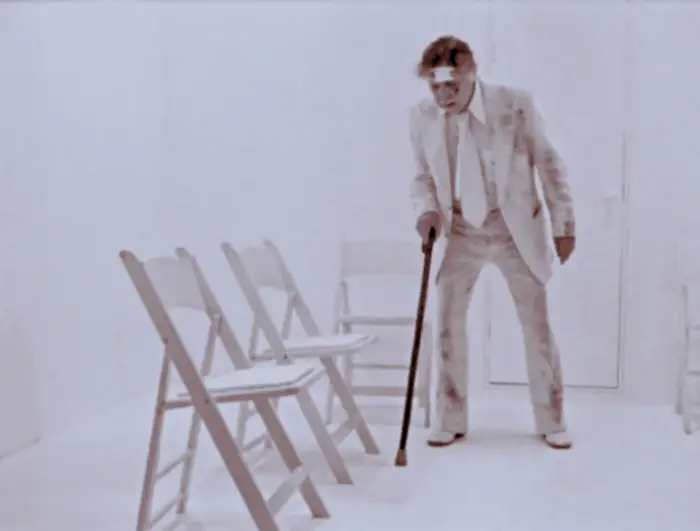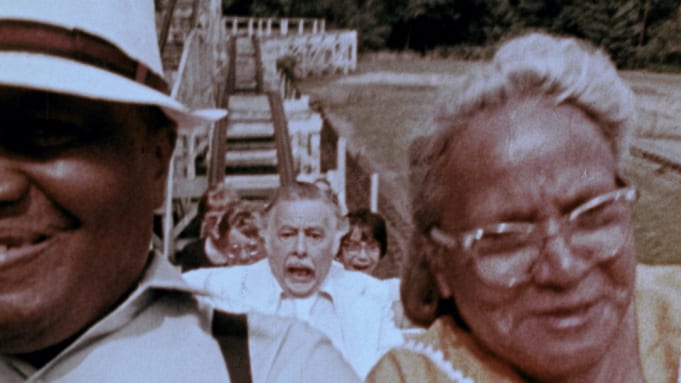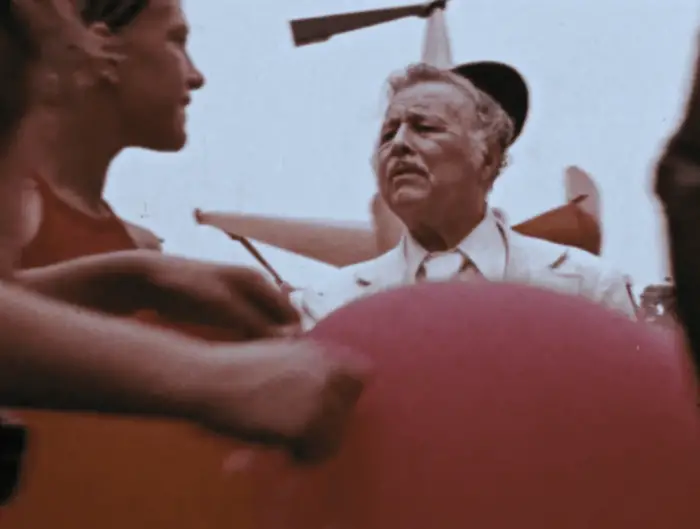Rediscovered and restored 46 years after it was first filmed only to see its release shelved by the Lutheran Society who initially commissioned it, The Amusement Park is one of the most unique, visceral films that George Romero ever made—a nauseating, claustrophobic roller coaster ride through the horrors that the elderly in America face on a daily basis and how the modern world makes just about all of us feel disconnected and alone.
As it is well known by now, Romero’s films were never as much about monsters as they were about us—Dawn of the Dead, in particular, is well known for drawing a clear line from mindless consumerism and overindulgence to the undead hordes that attack our heroes. What makes The Amusement Park so distinct is how it combines what is likely the most direct social commentary that Romero ever put on film paired with some of his most surreal and absurd imagery.
A Day at The Amusement Park
Take, for example, the early scene at the “restaurant.” What happens in this scene is fairly straightforward: a rich man is eagerly waited on by the staff of the park’s food service, while the Old Man—as I’ll be referring to Lincoln Mazall’s unnamed protagonist—is pushed off to the side and barely given a second thought. The waiters even go so far as to physically pick up and turn both the table and the rich man in his chair when he indicates that he doesn’t even want the Old Man’s table in his line of sight. The rich man feasts on lobster, while the Old Man is served what barely qualifies as food. It’s a scene that one could easily imagine happening anywhere in America, but the surreal, dreamlike way in which it’s presented to us turns it from something that would otherwise look over without a second thought into something that’s hard to forget.

For starters, the scene plays out more like a silent film than something out of a horror movie; everything from the exaggerated, pantomimed acting from the waitstaff to the jaunty piano music looping in the background brings the films of the ’20s and ’30s to mind. Then, there is the bizarre assortment of props used to highlight the absurdity of what we’re seeing: an oversized menu and pencil, a candelabra seemingly being pulled out of nowhere, and a bottle of champagne popped open at a table set up in front of a concession stand. Finally, Romero takes us one step further, continuously drawing us back to the crowd of people waiting along the edges of the “restaurant” that the waitstaff won’t even acknowledge, with a particular focus placed on two elderly African-American couples. This focus is not likely a coincidence, being filmed less than 10 years after the Civil Rights Act of 1964 and by the same guy who spent the final moments of Night of the Living Dead making a still-relevant statement on racism in America.
But the Old Man isn’t content with this state of things and instead chooses to invite these others to share what little he is given. Here, things take a nauseating turn as the elderly swarm his table, eagerly devouring the disgusting-looking meal that the Old Man had been served, while the waiters attempt to forcibly remove them and the rich man angrily pays his bill and leaves his table in disgust. It’s unclear whether his reaction is due to the behavior of the elderly or the fact that they were even allowed into the restaurant.
The Amusement Park is filled with moments like this. Watching the film feels, appropriately enough, as though you’re traveling through a hallway of funhouse mirrors: scenes are pulled out of everyday life and filtered through a bizarre, surreal lens that turns the mildly uncomfortable parts of life we would otherwise ignore into the stuff of nightmares—and the already nightmarish parts into something beyond even that.
There’s no overarching plot to The Amusement Park, which is simply a series of disconnected, disturbing events that grows more and more unbearable as it goes on. What is consistent is the themes that are reinforced again and again, the strongest of which is how deeply disconnected the modern world makes people feel from one another. We see several elements of this in the scene at the restaurant—the Old Man is made to feel disconnected from both the rich man who gets elevated above the masses and the people who are forced to wait outside and watch—but it’s an element that runs below the surface of almost the whole film.
Throughout the film, we are consistently presented with two opposing ways of approaching the world and the other people in it. The first, positive way is that of empathy, kindness, and humanization, embodied in the Old Man. Throughout the film, we consistently see him acting out of kindness and selflessness—helping the elderly woman off the roller coaster and back to her wheelchair, vouching for the elderly couple during the accident at the bumper cars, reading with the little girl at the end—as a way of trying to connect with the people around him. Sadly, these acts of kindness are time and time again met with indifference, if not outright hostility, only furthering the sense of disconnect both he and the audience feel from the other visitors to the park.
On the other side, we have the negative way of apathy, malice, and dehumanization. These traits are embodied by most of the other characters that we meet throughout the park: the man running the ticket table who takes people’s valuables and gives them next to nothing in exchange, the landlord who won’t make repairs on his building, and the retirement home salesman who promises people comfort and safety while literally stealing the money and valuables out of their pockets, to name just a few. Just as the Old Man attempts to connect to those around him through his actions, these individuals seek to make people feel disconnected from one another as a means of making them easier to take advantage of—and, just as the Old Man’s acts of kindness are met with hostility or indifference, the actions of the malicious and the indifferent are met with a sense of resignation, if not outright acceptance. After all, as we’re shown time and time again, there’s almost no chance that anyone will care, no matter how many times you might call out for help.

Finally, the film ends in the same way that it begins: two different versions of the Old Man in a sterile, white room. One is well dressed, cheerful, and curious about what lies outside; the other one is bandaged, disheveled, and tired, having clearly just come in from a day within the park. The disheveled man tries to warn the well-dressed man about going outside, insisting “you won’t like it out there” and “there’s nothing out there…nothing.” In the beginning, there’s a sense of ambiguity and surrealism to this scene.
There’s a lot that comes to mind when it comes to what the white room could represent: purgatory, a mental institution, or a hospital room, to name just a few. The second time around, however, gives this scene an entirely new, devastating meaning: dementia, possibly the greatest nightmare of growing older. We’ve seen the Old Man repeatedly be rejected, attacked, discriminated against, and isolated through film, and yet, he’s ready to go outside and experience the park all over again as though none of it ever happened. It’s the ultimate form of disconnection: being separated from your own memories, being unable to remember even your loved ones, even being separated from who you are. Yet, in a bizarre twist, that sterile white room turns out to be one of the few places of quiet and comfort to be found anywhere in the film’s world. The question we face is this: is it better to be inside that room, or is it better to be out there?
Sound and Fury
But Romero doesn’t want us to simply see the nightmares of the park. He wants us to experience them first hand. Everything about how the film is presented—the camera work, use of extras, and sound design—serves to simultaneously immerse us in the environment of the park while disconnecting us from the characters we are watching.
The camera work and sequencing of The Amusement Park turn the film into a chaotic, disorienting affair. The film makes frequent use of a point-of-view style of shooting; tight, often uncomfortable close-ups, low camera angles, and shaky camera work combine to put us directly in the middle of events and make the whole film a claustrophobic, anxious affair. The roller coaster ride early on, for instance, feels like it might throw us off at any moment and amplifies the look of sheer terror we see on the Old Man’s face.

Then, we have one of the most unique and disorienting techniques of The Amusement Park: Romero’s use of an almost non-stop sea of people moving throughout the park, turning a relatively straightforward metaphor for the non-stop pace of modern life into an anxiety-inducing onslaught. People are moving everywhere in The Amusement Park. They’re in the background, adding a sense of urgency and anxiousness to almost every frame. They’re used as obstacles to highlight a particular difficulty that the elderly face—notably, the couple having to take an eye exam to go on the bumper cars, only to have a crowd of people constantly moving between them and the eye chart. But the most unique way in which these crowds of people are used is how many scenes will have people walking directly in front of the camera. Where the frequent POV camera work serves to make us feel as though we are present in the park, the people constantly moving past us and breaking our line of sight creates a constant sense of disconnect between us and what we’re supposed to be watching.

But, despite their near-constant presence in the film, there’s little that’s comforting or familiar about these crowds of people. As Lincoln Mazaal explains in the introduction, most of the people we see in the park aren’t actually actors. They’re volunteers, many of whom were involved in the care of the elderly. The resulting effect is that these extras feel more like props than people, often moving past the Old Man as though he wasn’t even there. It’s a feeling all too familiar to anyone who experiences any sort of social anxiety: being in a crowd of people but still feeling alone and disconnected from everyone around you. Yet, there’s even deeper anxiety that is played into: the sense that the world is forever moving by us faster and faster as time goes by, and that one day we will be left behind, no matter how hard we try to keep up.
Just as we are visually overwhelmed with disorienting camera work and chaotic crowds, what’s arguably even worse is the sound design. It’s hard to put into words just how nauseating the sound design of the film is. It’s a harsh, grating blend of calliope music, ride noise, chatter, and a high-pitched ringing reminiscent of a hearing aid on the fritz that fades in and out while never fully going away. Much of the film is free of dialogue, and at times it feels like the endless noise is drowning it out, robbing us of yet another crucial point of connection between us and the characters. At times, it’s physically painful to listen to. Then, there are elements of sound used more sparingly to maximize their impact. A calm folk tune hints at the hope of a slower, more peaceful life that always feels just out of reach. The ominous chime of a grandfather clock seems to ring down the final hours before death. In a way, it’s similar to the effect achieved by the sound design of Tobe Hooper’s Texas Chainsaw Massacre. Where Hooper uses a similarly harsh onslaught of noise to bring to mind the brutality of slaughterhouses, Romero uses it to further drive home the sense that we are experiencing the film from the point of view of one of its elderly visitors, trying to find our way through just the same as the Old Man.
Just as the events that take place in the film emphasize how disconnected the Old Man feels from everyone around him, the way in which those scenes are actually filmed highlights the disconnect that we feel from him. We feel just as lost and trapped in that crowd as he is, but at the same time, we’re permanently separated from him, unable to help even if we wanted to.
Final Thoughts
While watching (and rewatching) The Amusement Park, another film frequently comes to mind: Elem Klimov’s seminal anti-war film Come and See. Both films take on deeply unpleasant subject matter in a way rarely seen, blending the surreal and the horrifyingly all-too-real to leave a lasting impression on their audiences. They both continuously bombard said audiences with visuals and noise to the point that one is left in the same worn-out, emotionally raw state as the characters on screen. Both of them even faced difficulties making it in front of an audience to begin with—Klimov fought eight years of Soviet censorship to get Come and See made, while Romero had his film shelved entirely by the Lutheran Society and was lost for 46 years before being rediscovered in 2019. And finally, while neither film is a “traditional” horror film in any sense, they are both uniquely horrifying in their own way.
The Amusement Park is one of the most difficult films I have ever watched. Writing about it from a purely objective point of view has been almost impossible, simply due to the fact that it has impacted me in a way no other film has since I watched Come and See almost four years ago. It left me feeling emotionally raw in the same way as the Old Man that we both begin and end the film on: isolated, alone, and on the verge of a complete breakdown. There are certain scenes—primarily the young couple’s nightmarish glimpse into their future of growing old together—that I don’t talk about here because I can’t bring myself to watch them again. They’re simply unbearable to watch, yet impossible to look away from.
But then, that’s almost certainly the point. We might not be able to help the Old Man, but there are plenty of people in the world facing the same horrors we have just seen that we can help, even something as simple as trying to connect with somebody so that they feel a little less alone in the world. This, then, is the ultimate bet that The Amusement Park makes: that there’s no way anyone can watch it and walk away without feeling called to do something about what they’ve just seen. In that way, The Amusement Park might just be the most important film that George Romero ever made.



